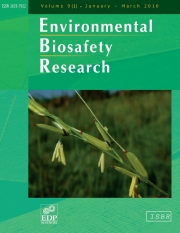Article contents
Pyrolysis-field ionization mass spectrometry of rhizodeposits – a new approach to identify potential effects of genetically modified plants on soil organisms
Published online by Cambridge University Press: 19 September 2006
Abstract
The objectives of the present study were (1) to investigate the qualitative composition of rhizodeposits leached from soils cropped with non-transgenic and genetically modified (GM) potatoes, and disclose if there were GM-specific modifications in potato rhizodeposition, and (2) to compare these results with conventional bulk parameters of microbial activity in soil. We have raised potatoes from a non-transgenic line (Solanum tuberosum L. cv. Désirée) and three GM lines, which expressed a gene for the resistance to kanamycin (DLH 9000) and a gene for T4 lysozyme (DL10 and DL12). A sandy soil placed in 340 cm3-“CombiSart” containers was used, from which the rhizodeposit was leached after a six-week growth period. The freeze-dried leachates were analyzed by pyrolysis-field ionization mass spectrometry (Py-FIMS). The Py-FI mass spectra gave detailed molecular-chemical information about the composition of leachates, indicating that the potato growth generally altered the composition of the soil solution. Moreover, a principal component analysis of the mass spectra showed differences between the leachates from the non-transgenic parent line and the GM potatoes as well as among the latter group. However, these differences in molecular composition could not be assigned to the release of T4-lysozyme into soil. Dehydrogenase activity and substrate-induced soil respiration as more common bulk parameters of soil microbial activity failed to disclose any significant effects of the various potatoes grown. The limitations of the described rhizodeposit leaching and analysis for risk assessment of GM potato cropping under field conditions are discussed critically. However, it could be concluded that the Py-FI mass spectrometric “fingerprint” can be developed as a fast, comprehensive, highly sensitive and reproducible analytical approach to discern any effects GM-crops may exert on soil ecological parameters.
Keywords
Information
- Type
- Research Article
- Information
- Copyright
- © ISBR, EDP Sciences, 2006
References
- 10
- Cited by

